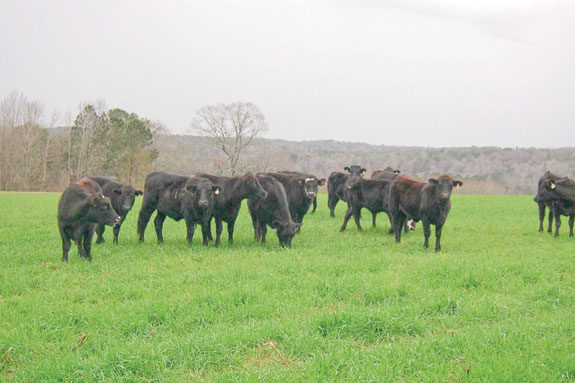Many producers are seeking ways to evaluate cost efficiency, and there is particular interest in comparing levels of production and cost of gain from legumes or legume/grass mixtures for animals grazing grass-only pastures.
In Alabama, numerous stocker cattle grazing experiments have been conducted by Auburn University personnel. These have generally involved crossbred animals of similar breeding and weights, and were conducted over multiple years.
These studies have included grass-only, legume-only and legume-grass mixtures, and therefore provide a good basis for comparison of both the animal production potential and the production costs of various forage species.
In order to make the desired comparisons, stocker cattle performance data from 37 different pasture treatments used in Auburn University grazing studies were compiled from various research reports (Table 1).
 Subsequently, Auburn University 2008 budget estimates were used to calculate the approximate pasture costs per acre and the pasture costs per pound of gain for each pasture treatment. This provided an economic comparison of these treatments in terms of 2008 economic conditions.
Subsequently, Auburn University 2008 budget estimates were used to calculate the approximate pasture costs per acre and the pasture costs per pound of gain for each pasture treatment. This provided an economic comparison of these treatments in terms of 2008 economic conditions.
As expected, the animal performance reported in these experiments varied greatly among the various pasture species or mixtures. The number of calendar grazing days ranged from a low of 77 for sorghum-sudan to a high of 238 for an orchardgrass-white clover mixture.
Per-day gains of 1.7 pounds or more had been obtained with alfalfa, continuously grazed AU Lotan sericea lespedeza, tall fescue having low or medium endophyte infection, common orchardgrass, hardinggrass, orchardgrass with ladino clover and tall fescue with ladino clover.
The gain per acre was at least 475 pounds on 10 of the pasture treatments. These were alfalfa, Coastal bermudagrass receiving at least 160 pounds of nitrogen per acre, Coastal bermudagrass overseeded with vetch or rye, endophyte-free AU Triumph tall fescue, endophyte-infected tall fescue-white clover (SM), Hallmark orchardgrass-white clover, and with two of the four winter annual mixtures. The lowest gain per acre (100 pounds) was obtained on common bermudagrass receiving no nitrogen fertilizer.
While numerous points of interest were revealed by this exercise, foremost among them is the economic importance of using forage legumes. Only 15 of the 37 Alabama pasture treatments involved legumes, but the seven lowest calculated pasture costs per pound of gain involved legumes.
These were Tall Fescue with Ladino clover (Item No. 32, $0.30 per pound of gain), Orchardgrass with Ladino clover (Item No. 29, $0.30 per pound of gain), Tall Fescue with Ladino clover (Item No. 33, $0.40 per pound of gain), Bermudagrass with vetch (Item No. 11, $0.47 per pound of gain), Sericea Lespedeza (Item No. 17, $0.49 per pound of gain), Sericea Lespedeza (Item 16, $0.54 per pound of gain) and Sericea Lespedeza (Item 15, $0.60 per pound of gain). Eight of the 10 lowest calculated costs per pound of gain involved legumes.
It appears that improved forage quality of legumes resulted in better animal gains in these tests. Additionally, fertilizer costs were reduced due to the use of legumes. Thus, the higher level of performance when combined with lower costs resulted in substantially lower calculated pasture cost per pound of gain when legumes were included in stocker cattle pastures.
This provides strong evidence in support of an important concept: Stocker cattle producers who are able to increase animal performance via providing higher-quality pasture and/or who are able to lower fertilizer input costs (with legumes or by other means) can achieve lower pasture costs per acre and lower costs per pound of gain.
Of the 37 treatments, only five had less than a $0.50 total cost per pound of gain. Careful assessment of performance, costs, and pasture cost per pound of gain are the crux of sound stocker pasture decisions. FG
Click on the table above to open image in new window.

Don Ball
Extension Agronomist
Auburn University







